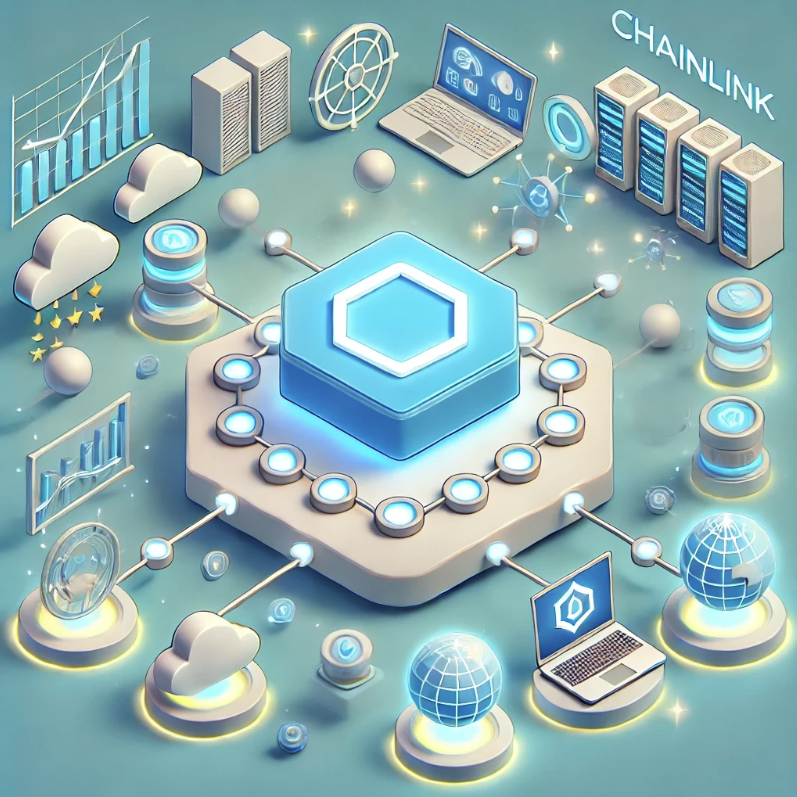ChainLink Unveiled: The Mechanics of a Hybrid System
ChainLink functions through a web of independent nodes tasked with retrieving, validating, and relaying off-chain data to on-chain contracts. Unlike centralized oracles, which hinge on a solitary data provider (and thus a fragile single point), ChainLink disperses this burden across its network. Node operators stake LINK tokens as a guarantee of fidelity, with economic incentives rewarding precision and punishing errors. By aggregating data from varied sources, the system aims to bolster trustworthiness—a marked departure from the risks of lone feeds.
By March 2025, ChainLink anchors pivotal blockchain sectors, from decentralized finance (DeFi) to tokenized assets and cross-chain frameworks, boasting a market capitalization nearing $16 billion CoinGecko. Its collaborations with titans like Oracle and Polygon amplify its stature. However, a closer look reveals cracks in its decentralized facade. The concentration of node activity and dependence on often-centralized external inputs complicate its narrative, prompting scrutiny of its foundational claims.
The Shadow of Centralization: Risks Beneath the Surface
Skeptics contend that ChainLink’s decentralization falls short of absolute. A key concern lies in its node ecosystem. If a small cadre of operators dominates data provision, the network veers toward an oligopolistic structure, eroding its distributed promise. Recent 2024 analyses indicate that a handful of high-performing nodes process a significant volume of requests, raising flags about potential choke points CryptoSlate.
Further, ChainLink’s reliance on off-chain data sources exposes a structural paradox. Many inputs think centralized exchanges or proprietary APIs—originate from singular entities, tethering the “trustless” blockchain to traditional gatekeepers. Dubbed the “oracle problem,” this dependency challenges the notion of end-to-end decentralization. A notable 2024 glitch, where an erroneous feed briefly destabilized a DeFi platform, underscored this fragility The Block.
Additional pressure stems from governance. While ChainLink’s operations are decentralized, its development roadmap and token economics rest partly with its founding team and early stakeholders. This dynamic echoes broader blockchain critiques, as seen with Ethereum’s validator debates post-merge Forbes. Can ChainLink’s model withstand these tensions, or does it risk drifting toward centralization by necessity?
The Case for Centralization: Pragmatism Over Purity
Centralization, despite its detractors, brings tangible benefits to the table. A unified oracle could streamline data delivery, slashing latency and costs—a boon for time-sensitive applications like high-frequency trading contracts. In scenarios demanding precision over ideology, such as trillion-dollar insurance payouts, a centralized system’s predictability might outshine decentralization’s allure. Rival projects like API3 wrestle with similar trade-offs, while centralized players like Pyth Network thrive on simplicity Medium.
ChainLink’s hybrid design navigates this spectrum. Its decentralized framework guards against catastrophic failures, yet its layered processes—node coordination, staking mechanisms—cede ground to centralized speed. This balancing act defines its conundrum: can it meld the robustness of decentralization with the agility of centralization, or must it choose a side?
ChainLink’s Ripple Effect: Shaping Blockchain’s Horizon
ChainLink’s journey reverberates across the blockchain sphere in 2025. DeFi, with its $200 billion in locked value, leans heavily on ChainLink’s oracles for price feeds and settlement triggers DeFi Pulse. A breach here could cascade into market-wide panic. Likewise, its Cross-Chain Interoperability Protocol (CCIP) underpins bridges between blockchains like Solana and Avalanche, where flawless data flow is non-negotiable Chainlink Blog.
Beyond DeFi, ChainLink fuels enterprise adoption. Its integration with supply chain tracking and climate data platforms signals blockchain’s real-world potential. Yet, each use case amplifies the stakes. A faltering oracle network could dent trust in decentralized systems, stalling their mainstream ascent. Conversely, a thriving ChainLink could cement oracles as the backbone of a hybrid digital economy.
This tension mirrors industry-wide shifts. Solana’s emphasis on throughput over full decentralization and Binance Smart Chain’s centralized validator model highlight the pragmatic compromises afoot CoinDesk. ChainLink’s outcome could either validate the decentralized dream or nudge the ecosystem toward a more centralized equilibrium.
Navigating the Divide: Strategies for Resolution
Addressing ChainLink’s conundrum demands a blend of innovation and realism. Consider these pathways:
- Broaden Node Participation: Subsidize smaller operators to diversify the network, reducing reliance on dominant players.
- Enhance Data Resilience: Source inputs from multiple, uncorrelated providers to dilute centralized dependencies.
- Open Governance: Decentralize decision-making further, empowering the community over core developers.
- Adaptive Models: Deploy tiered oracle systems—centralized for low-stakes tasks, decentralized for high-value contracts.
- Real-Time Monitoring: Implement dashboards tracking node health and data integrity IEEE.
Pilot programs in 2024 suggest that optimized oracle networks can achieve uptime exceeding 98%, nearing centralized benchmarks Springer. Such advances could fortify ChainLink’s position, marrying ideological roots with operational rigor.
Conclusion
ChainLink encapsulates the centralization-decentralization paradox that animates blockchain’s evolution. Its decentralized oracle network has unlocked new frontiers for smart contracts, yet its compromises lay bare the challenges of translating theory into practice. As of March 2025, the conundrum persists—a proving ground for blockchain’s aspirations.
The resolution lies not in ideological extremes, but in a tempered synthesis. ChainLink must evolve to counter its vulnerabilities while harnessing centralization’s strengths where they serve the greater good. Its success or shortfall will echo beyond its own ecosystem, influencing how decentralized technologies integrate with a world that remains stubbornly centralized. In this delicate dance, ChainLink holds a mirror to blockchain’s promise—and its limits.
Sources
Chainlink Official Site
CoinGecko - Chainlink Stats
CryptoSlate - Node Concentration
The Block - Oracle Mishap
Forbes - Blockchain Governance
Medium - Centralized Oracles
DeFi Pulse - Market Data
Chainlink Blog - CCIP Updates
CoinDesk - Industry Trends
IEEE - Oracle Reliability






































